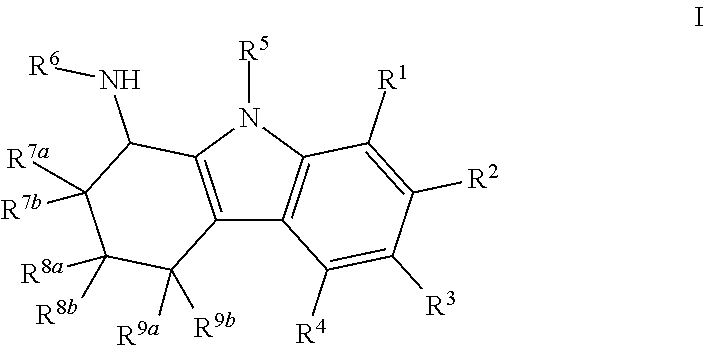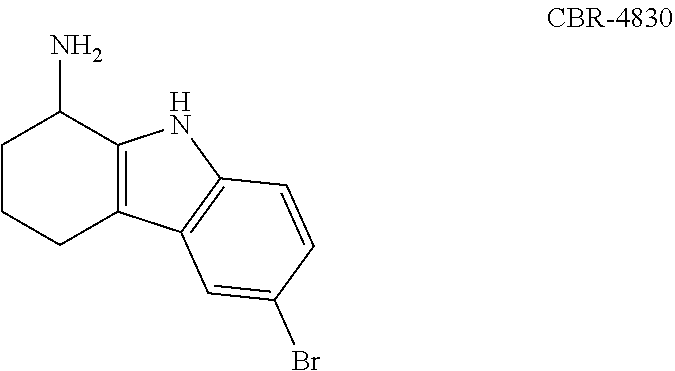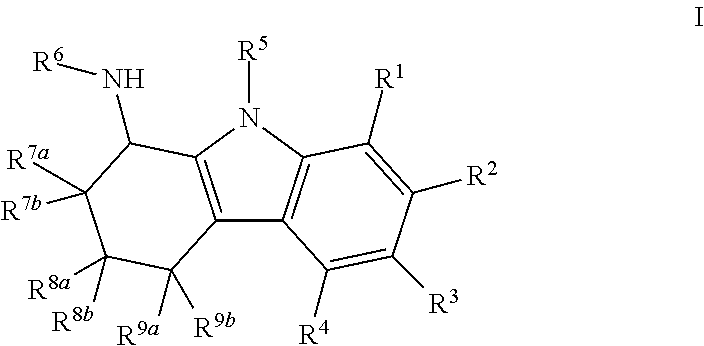Therapeutic compounds and methods to treat infection
a technology applied in the field of therapeutic compounds and methods to treat infections, can solve the problems of increasing morbidity and mortality, threatening the clinical utility of antibacterial therapy, and prolonging patient hospitalization
- Summary
- Abstract
- Description
- Claims
- Application Information
AI Technical Summary
Problems solved by technology
Method used
Image
Examples
example 1
[0479]
6-Bromo-2,3,4,9-tetrahydro-1H-carbazol-1-amine
[0480]6-Bromo-2,3,4,9-tetrahydro-1H-carbazol-1-one (250 mg, 0.95 mmol), ammonium acetate (732 mg, 9.5 mmol) and sodium cyanoborohydride (298 mg, 4.75 mmol) were dissolved in methanol (5 mL). The reaction mixture was stirred for overnight at 60° C. After removal of the solvent, the reaction mixture was diluted with ethyl acetate. The organic layer was washed with 10% NaOH and brine, and it was dried over Na2SO4. The organic layer was concentrated under reduced pressure. The residue was purified on an ISCO chromatograph (0-10% methanol / dichloromethane+0.1% NH4OH) to give the product as a white solid (127 mg, 50%); 1H NMR (300 MHz) (CD3OD) δ 7.49 (s, 1H), 7.19 (d, J=9 Hz, 1H), 7.12 (dd, J=9 Hz, J=2 Hz, 1H), 4.05 (t, J=6 Hz, 1H), 2.62 (t, J=6 Hz, 2H), 2.19-1.99 (m, 2H), 1.82-1.66 (m, 2H); LC / MS RT=2.62 (M−H−: 263 / 265).
a. Preparation of Compound
[0481]
6-Bromo-2,3,4,9-tetrahydro-1H-carbazol-1-one
[0482]A solution of 4-bromophenyl hydrazine...
example 2
[0483]
6-(4-Fluorophenyl)-2,3,4,9-tetrahydro-1H-carbazol-1-amine
[0484]6-Bromo-2,3,4,9-tetrahydro-1H-carbazol-1-amine (70 mg, 0.26 mmol), (4-fluorophenyl)boronic acid (109 mg, 0.78 mmol), Pd(PPh3)4 (35 mg, 0.03 mmol) and K2CO3 (108 mg, 0.78 mmol) were dissolved in a mixture of dioxane (3 mL) and water (1 mL). The air was evacuated from the reaction flask and replaced with N2. The reaction mixture was then refluxed overnight. Reaction was monitored by TLC and stopped once the starting material was consumed. The reaction mixture was diluted with ethyl acetate, and it was washed with water followed by brine. The organic layer was dried over Na2SO4 and was concentrated under reduced pressure. The residue was purified on an ISCO chromatograph (0-10% methanol / dichloromethane+0.1% NH4OH) to give the product as a white solid (14 mg, 19%); 1H NMR (300 MHz) (CDCl3) δ; 8.54 (s, 1H), 7.61-7.56 (m, 3H), 7.35-7.34 (m, 2H), 7.11 (t, J=9 Hz, 2H), 4.09 (t, J=6 Hz, 1H), 2.75-2.71 (m, 2H), 2.23-2.19 (m,...
example 3
[0485]
6-(4-Methoxyphenyl)-2,3,4,9-tetrahydro-1H-carbazol-1-amine
[0486]6-Bromo-2,3,4,9-tetrahydro-1H-carbazol-1-amine (75 mg, 0.28 mmol), (4-methoxyphenyl)boronic acid (128 mg, 0.84 mmol), Pd(PPh3)4 (35 mg, 0.03 mmol) and K2CO3 (116 mg, 0.84 mmol) were dissolved in a mixture of dioxane (3 mL) and water (1 mL). The air was evacuated from the reaction flask and replaced with N2. The reaction mixture was then refluxed overnight. Reaction was monitored by TLC and stopped once the starting material was consumed. The reaction mixture was diluted with ethyl acetate, and it was washed with water followed by brine. The organic layer was dried over Na2SO4 and was concentrated under reduced pressure. The residue was purified on an ISCO chromatograph (0-10% methanol / dichloromethane+0.1% NH4OH) to give the product as a white solid (53 mg, 63%); 1H NMR (300 MHz) (CDCl3) δ 8.58 (s, 1H), 7.62-7.56 (m, 3H), 7.35 (m, 2H), 6.98 (d, J=9 Hz, 2H), 4.10 (t, J=6 Hz, 1H), 3.85 (s, 3H), 2.75-2.69 (m, 2H), 2.2...
PUM
| Property | Measurement | Unit |
|---|---|---|
| concentration | aaaaa | aaaaa |
| temperature | aaaaa | aaaaa |
| temperature | aaaaa | aaaaa |
Abstract
Description
Claims
Application Information
 Login to view more
Login to view more - R&D Engineer
- R&D Manager
- IP Professional
- Industry Leading Data Capabilities
- Powerful AI technology
- Patent DNA Extraction
Browse by: Latest US Patents, China's latest patents, Technical Efficacy Thesaurus, Application Domain, Technology Topic.
© 2024 PatSnap. All rights reserved.Legal|Privacy policy|Modern Slavery Act Transparency Statement|Sitemap



